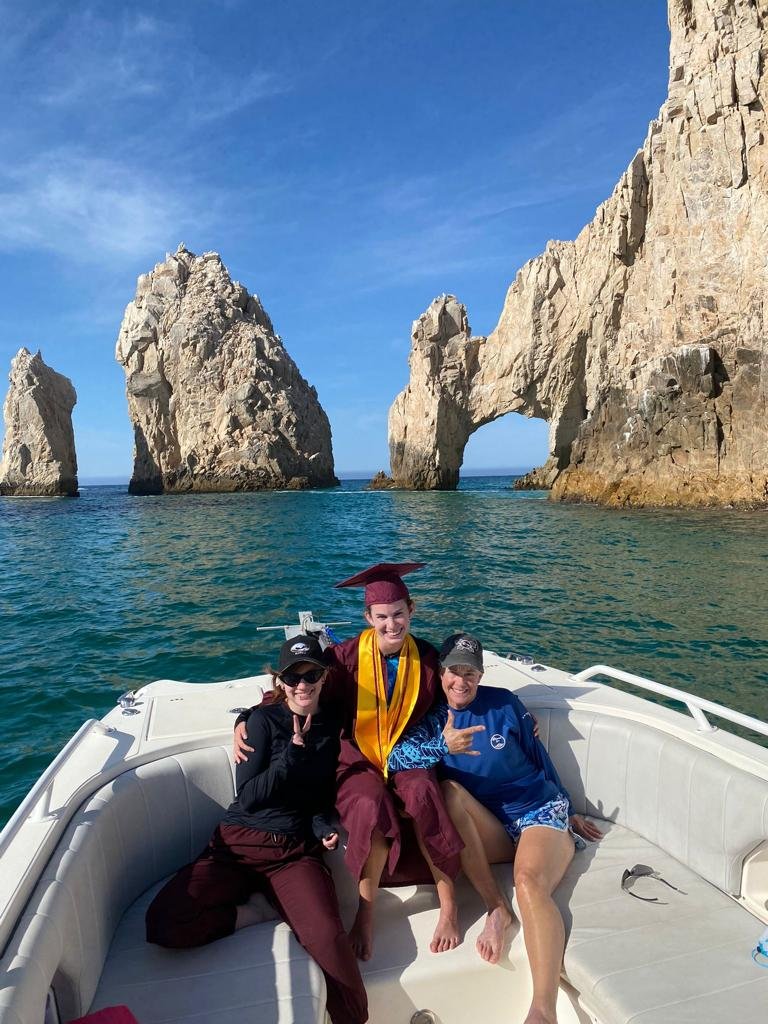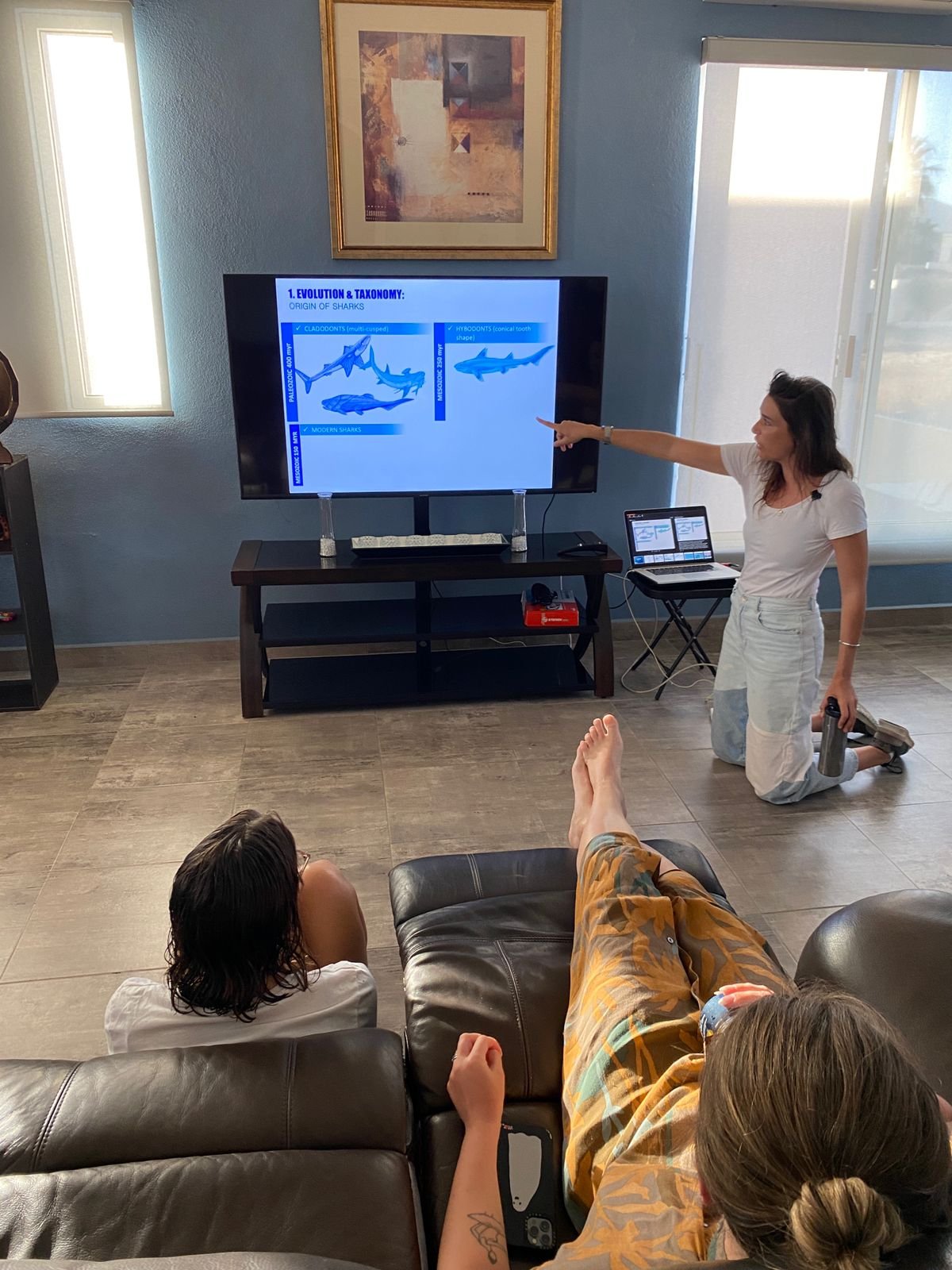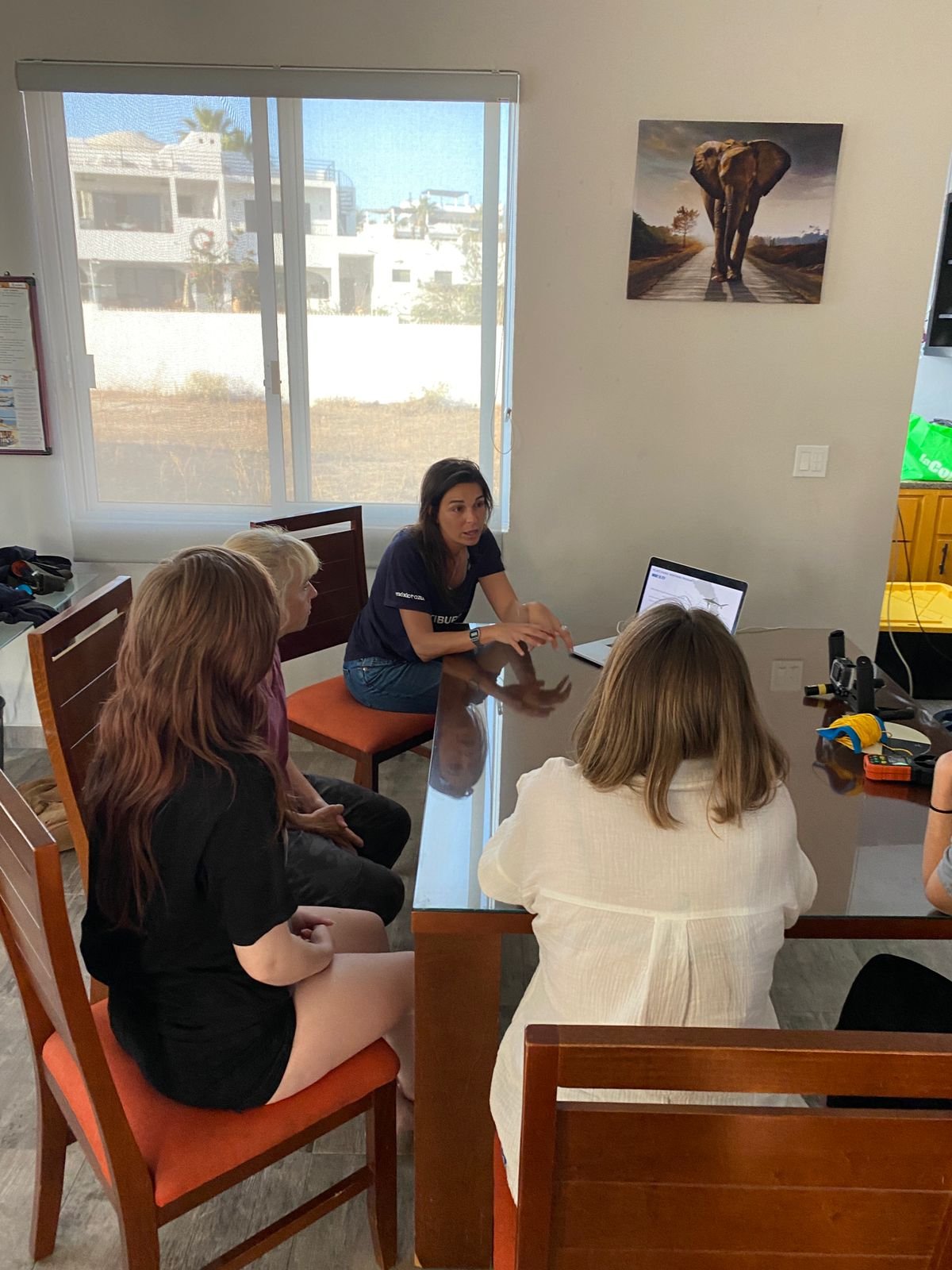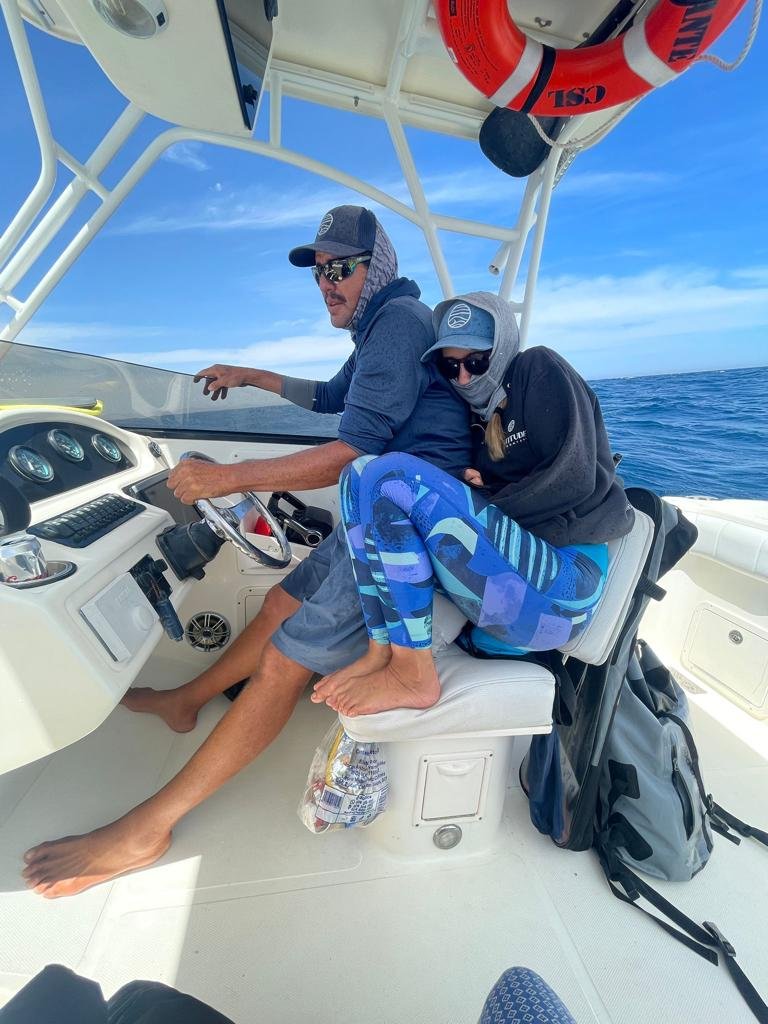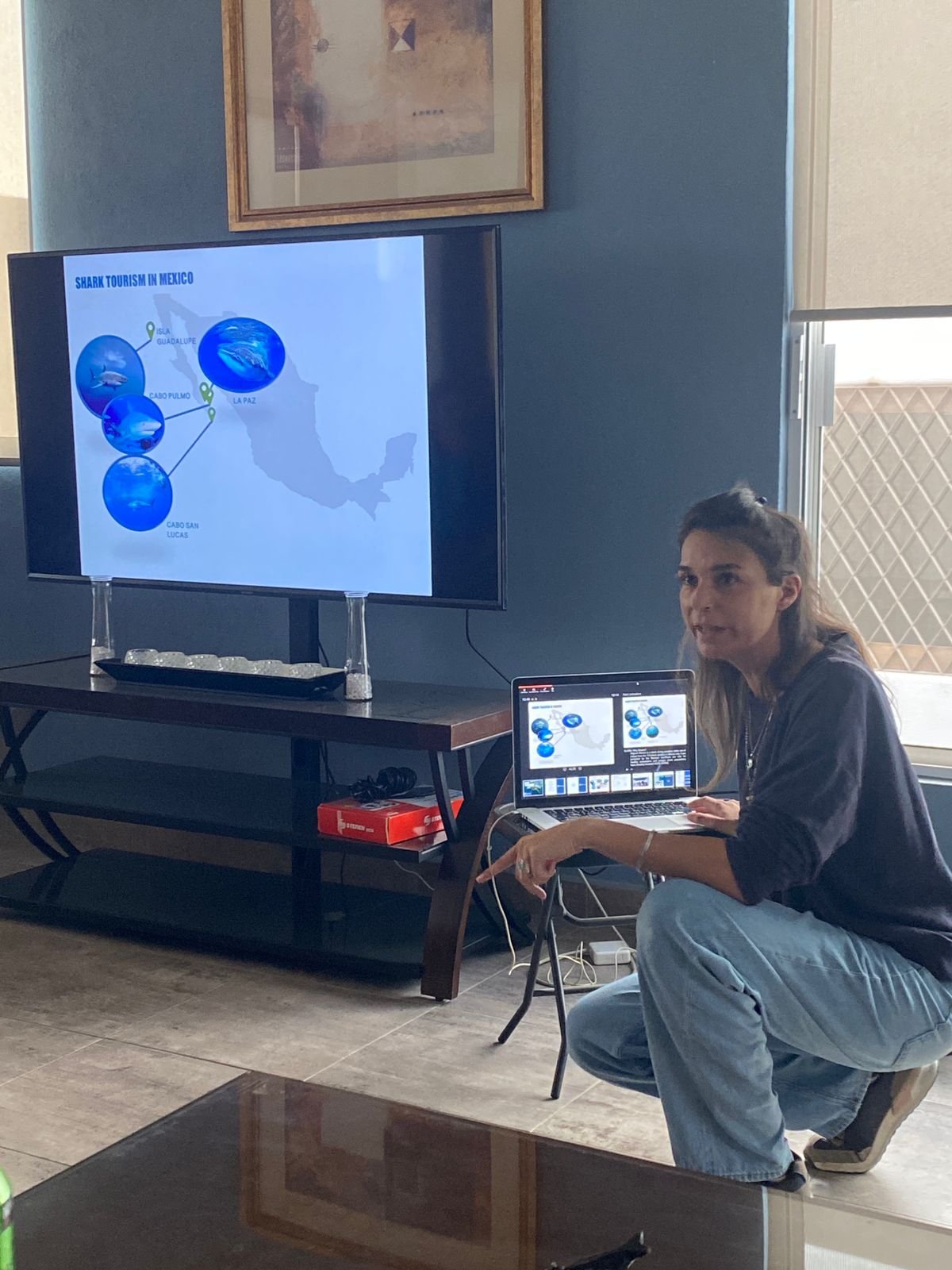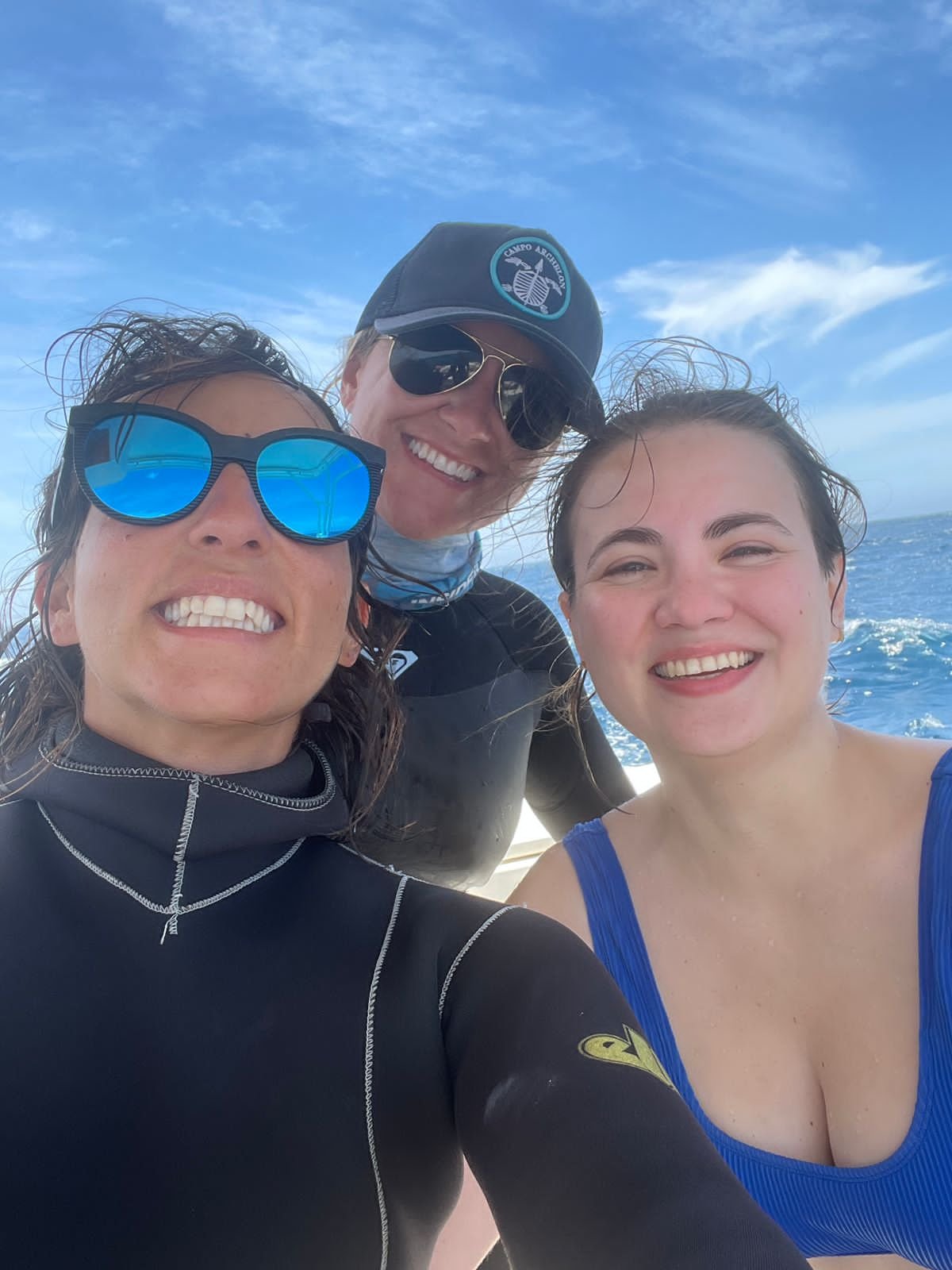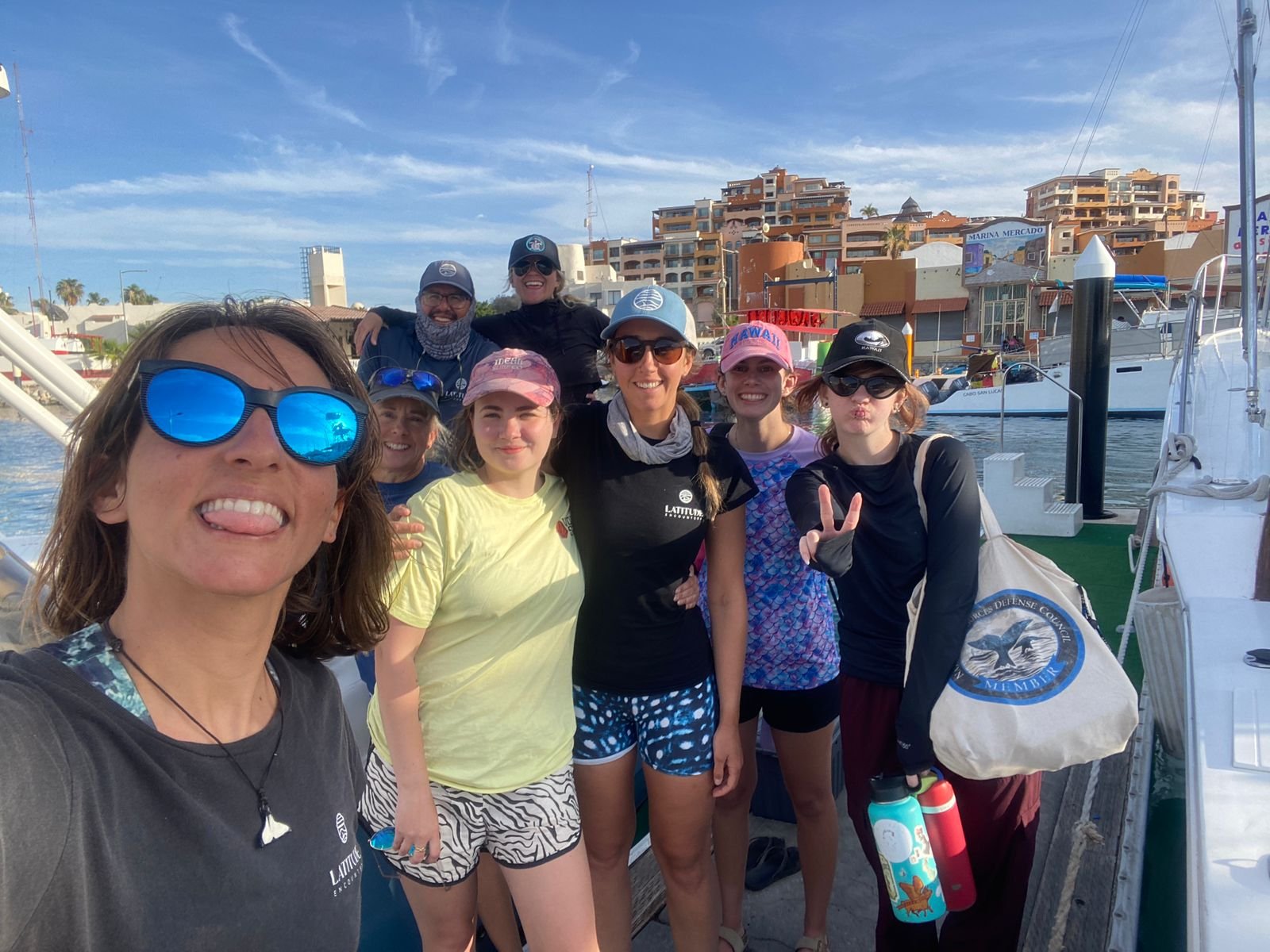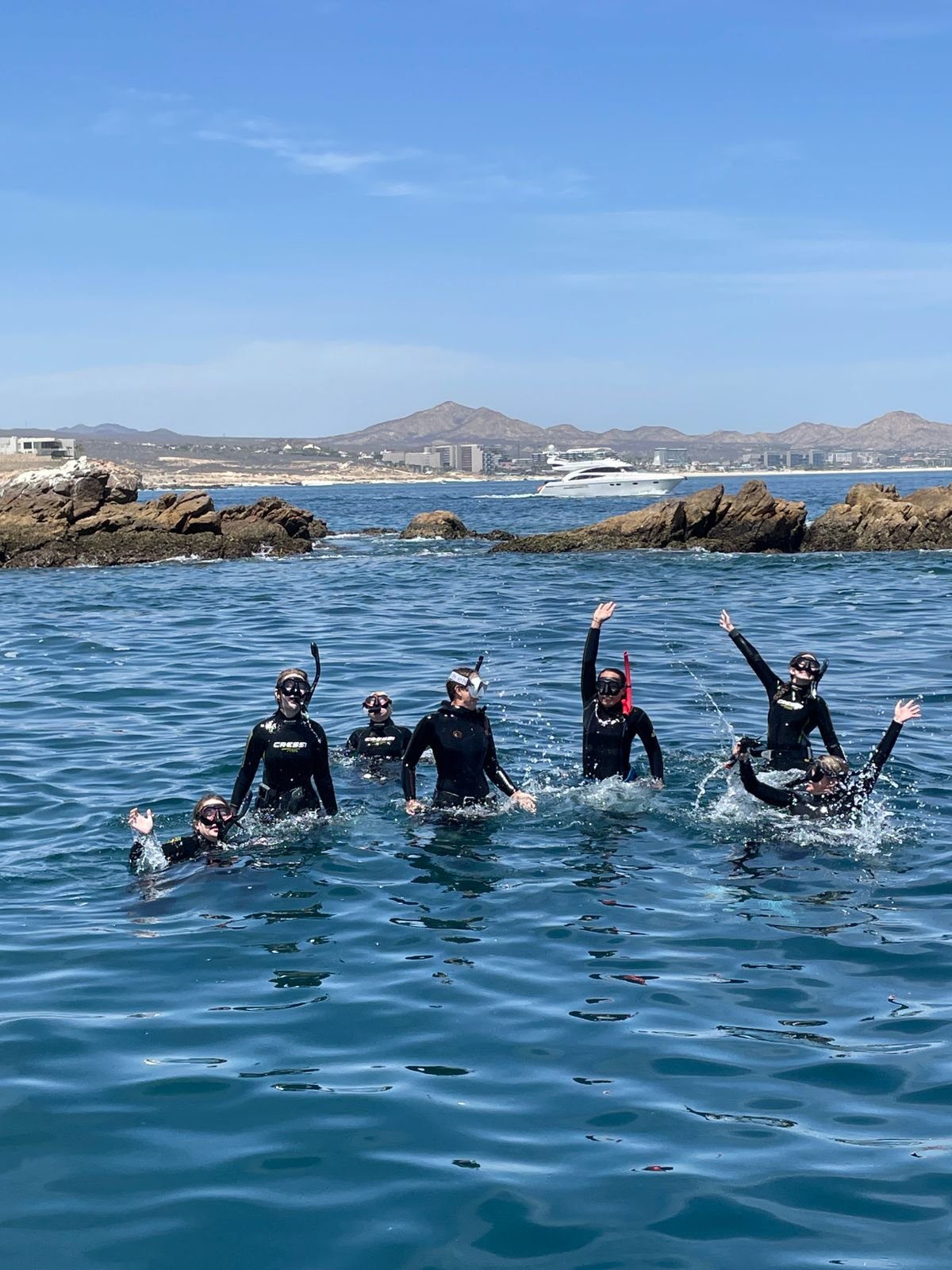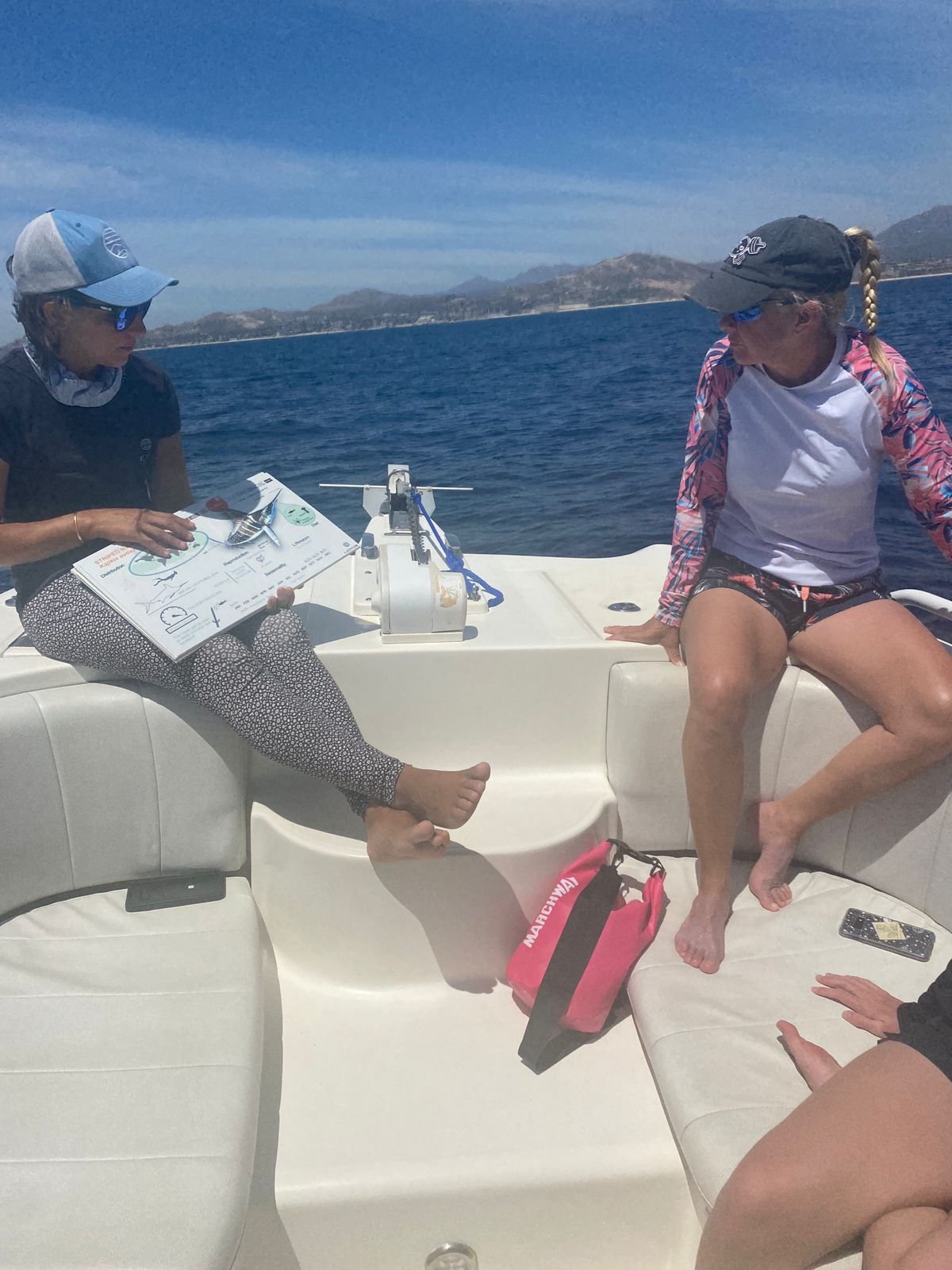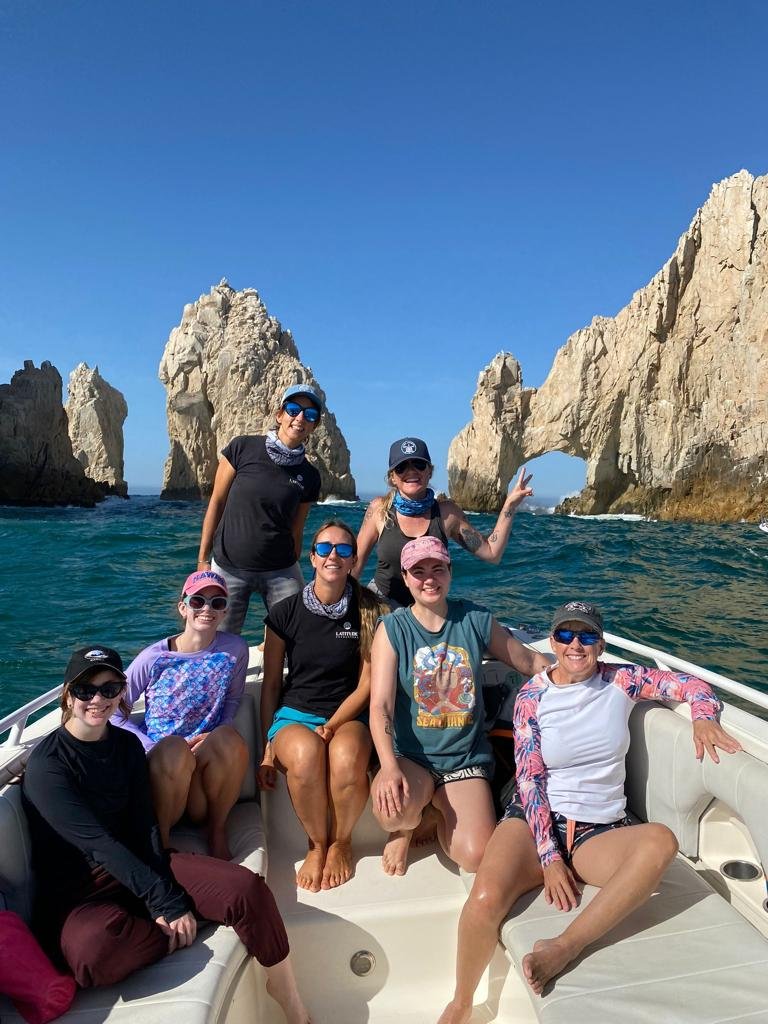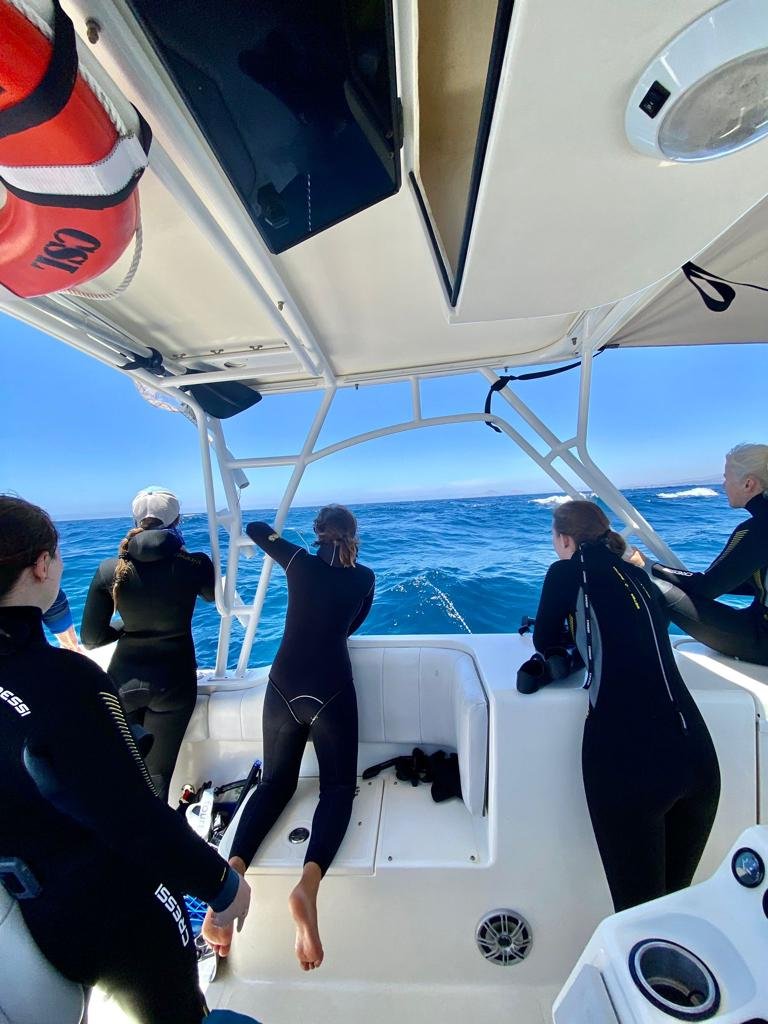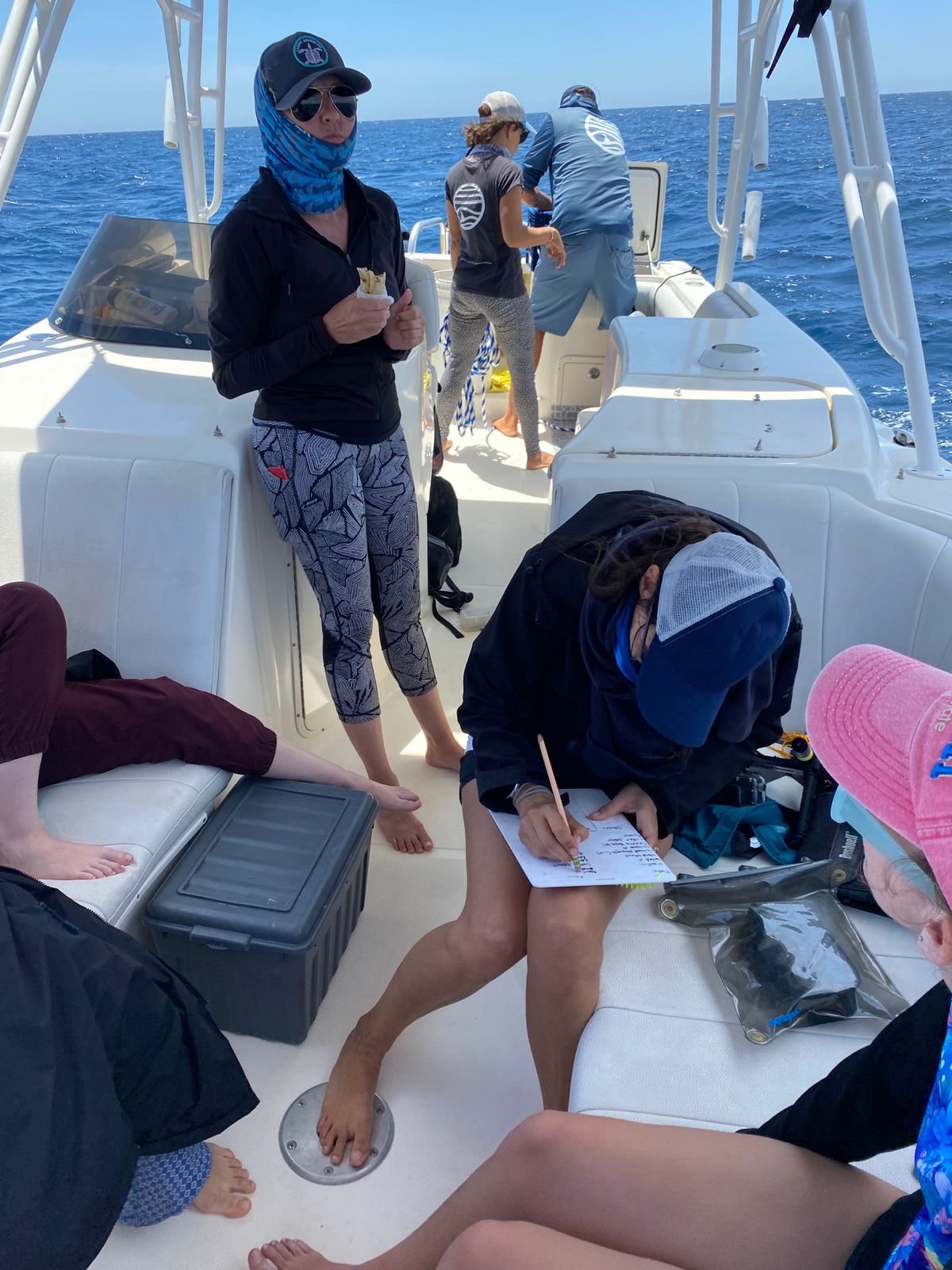Expedition Report: Women in Ocean Science II
Our second Women in Science and Pelagic Shark retreat finished this week, and the trip was a success! Despite very bad weather for most of the week, we managed to get everyone snorkeling with Mako sharks, and on one of our ocean days, we were lucky enough to come across a super pod of sperm whales (at least 100 whales) that were migrating into the Sea of Cortez.
Text by Dr. Katy Ayres
Arrival Day – Fernanda picked up the guests Beth, Sage, and Dani from the airport and met the rest of the group: Taya, Clara, and myself at Tropical Kitchen café, where we all had smoothies and got to know each other. We ended up talking more about our dogs than sharks, but we could tell we were all going to get along fine as animal lovers, and that there would be plenty of time for shark talk over the duration of the week. We arrived at the Airbnb that we used for our first Women in Science expedition, which has views of the famous Cabo Arch, a swimming pool, and a hot tub on the roof. Our private chefs prepared us a 3-course meal as Fernanda gave a briefing on our plan for the week. Clara then gave us a presentation all about the pelagic sharks we would be searching for and the monitoring project that she has been running since 2016 and how our guests would be helping collect the data. Dinner was then ready, and we had ‘Chile Relleno’ for our main, which is a traditional Mexican dish made from roasted poblano peppers stuffed with cheese and fried with a red tomato salsa on top, delicious! Abbey, our final guest, arrived at the house after catching a later flight and caught up quickly with Fernanda and me before heading to her room to get some rest for the next day on the ocean.
Ocean Day 1. We left the marina at 8 am and headed to one of our shark spots. The group got a very thorough briefing on the characteristics of each shark species and how to identify them. I then gave a safety briefing of our rules, how to enter/exit the water, how to interact with sharks in the water, and explained the equipment we use to keep the sharks around the boat. The sharks we are searching for are pelagic, meaning that they are found high in the water column and can be widely dispersed. For this reason, we have to attract the sharks to the boat by chumming (adding fish blood into the water), which Fernanda and our captain, Andres, started right away. Everyone got into their wetsuit, and Clara explained the data collection method that we complete every time we survey for sharks. We record environmental variables, including wind speed and direction (which we measure with an anemometer), water visibility (which we measure with a device called a Secchi disk), water color, water temperature, current speed and direction, and site location. Everyone measured a variable, and Clara demonstrated how to fill in the datasheet. After around an hour, we got our first visitor, a small smooth hammerhead shark! Unfortunately, it didn’t stick around long enough to snorkel with as this species is generally very shy, but we recorded the sighting on the datasheet. We waited patiently, hoping some braver sharks would show up, but we had to head back to the marina as the weather got even windier. In the evening, Clara gave us a presentation on shark evolution and biology where everyone got to learn in detail when and how sharks became perfectly adapted to their environment. Later on, for dinner, we had creamy mushroom pasta AND homemade pizza!
Ocean Day 2
The second day was also very windy but we headed to one of our spots that was more sheltered by the wind than in the Pacific. After an hour of chumming, a shark showed up, and this time it wasn't a hammerhead, it was a mako shark! Mako sharks are an endangered species, and it really is an honor to see them in the wild. We often say on the boat, "Please don't scare the sharks". This is because, for the most part, sharks can be pretty skittish, and if it weren't for chumming, they would not stay around to have an encounter. On our tours, the guide always gets in first to evaluate the behavior of the shark – if the shark is very confident, it will swim over to the guide without being cautious to assert dominance. If the shark is shy, it will often keep its distance. If the latter is the case, not everyone will enter the water at the same time so as to not intimidate the shark more. Unfortunately, on this occasion when I entered the water, the shark came over and checked me out before deciding that it wasn't hungry enough to stick around and swam off into the blue. This, plus the increasingly bad weather, meant we had to try our luck the next day. Back at the house, I gave a presentation about my PhD research and showed drone videos from my project in Cabo Pulmo National Park where I study shark aggregations along the coastline.
Ocean Day 3.
On the third day, we started our day with a photo at the arch, a very special photo – Sage's graduation photo! She brought her graduation gown and hat on the boat to celebrate as she is about to graduate when she returns home. Shortly after, we came across a humpback calf and mum breaching out of the water, which was very special as the humpback whale season has just finished here in Cabo, so they were some of the last remaining whales yet to migrate north. After watching the calf breach several times, we headed to our shark spot. One of our guests, Dani, managed to overcome her seasickness and got in the water, and practiced snorkeling up and down the safety line to make sure she was comfortable before the added thrill of a mako shark. We spent all day on the ocean telling stories, and Fernanda and Abbey were sharing their experiences of sperm whales as they had both gone to Dominica earlier in the year where it is possible to swim with them. The wind had picked up, so we were moving to a more sheltered shark spot when suddenly we saw some blows. "They are sperm whales! They are logging!!" Shouted Abbey.
Logging is when whales are resting, and their bodies are exposed to the surface. Sperm whales are like giant buses with huge square heads and are the largest toothed predator on the planet and have the largest brain of any animal. We looked around and realized that the whole ocean to the horizon was full of sperm whale blows, and many were breaching completely out of the water. We spent the rest of the afternoon slowly following this super pod, which included huge males and even tiny calves (well tiny for a sperm whale). We put our hydrophone in the water to listen to their clicks, and we could hear a male which sounds like metal clanging together. We headed home as early evening set in and couldn't believe how lucky we were to catch their migration into the Sea of Cortez. Back at the house, we enjoyed the chef's homemade Sushi!
Ocean Day 4. The next day our shark luck changed and after a chumming for a little while we got what I call a ‘contender’ shark, a shark that sticks around and wants to play! She was a nice-sized mako shark around 1.5m in length and everyone couldn’t wait to see her. I got in first, closely followed by Abbey and Taya and then Fernanda, Sage, Beth, and Dani. The mako shark vertically swam up to the fish head and tried to bite it and then proceeded to check everyone out. The conditions were very rough and so we all held onto the safety line as the mako shark swam around us. Not before long a second mako shark of a similar shark showed up. These sharks were not only everyone’s first-ever mako sharks but were Beth, Sage, and Dani’s first-ever shark encounter and it was a special moment to share with them. We spent over an hour with the sharks before the weather picked up so we had to say bye to the mako sharks and we headed to a sheltered reef area called Chileno. Here we spent the afternoon snorkeling with white tip reef sharks on the reef in much calmer conditions where we got a group photo. It was a great sharky day! Back at the house, Clara gave a presentation on the pros and cons of Shark Tourism and we talked about shark tourism in other parts of Mexico where Fernanda and Clara used to work as well as Fiji where I have experience working. Ocean Day 5. The wind did not give up and our final day was by far the windiest unfortunately, we couldn’t go to any of our usual shark spots and had no luck in finding sharks. That evening I was about to give a presentation about my and Clara’s research paper that we wrote on the findings of Clara’s data collection on the pelagic sharks over the years when we received an email – our paper was accepted for publication!! We got very emotional as this project was started by Clara in 2016 and is the outcome of her hard work and determination. I then presented our paper results showing how each environmental variable that we had been collecting all week influences the presence of each pelagic species and explained the process of publishing scientific manuscripts. We finished the evening off with a shark quiz which Dani won and she received a t-shirt with a mako shark on which she was very happy about. Clara, Fer, and I spent the whole week sharing our stories and experiences as women working in male-dominated fields (shark science and the diving industry) as well as solo traveling and we hope every woman on the trip left feeling inspired and capable of following their own dreams too.




